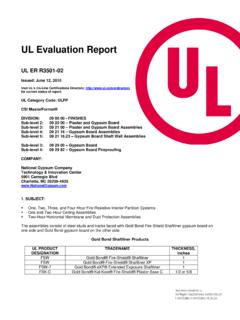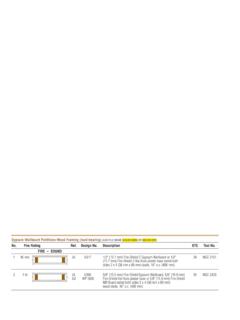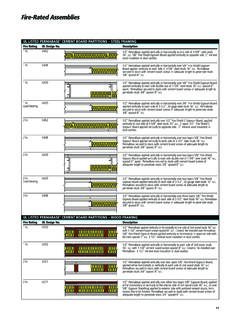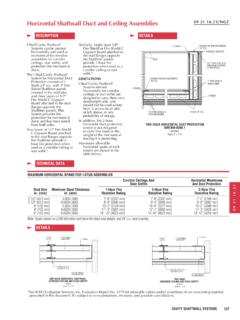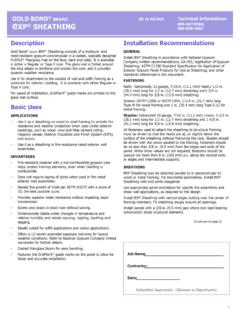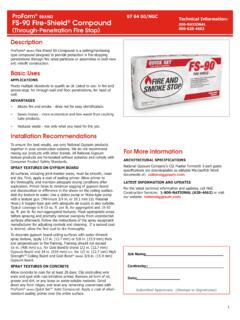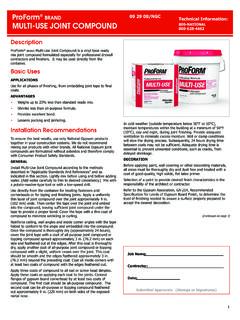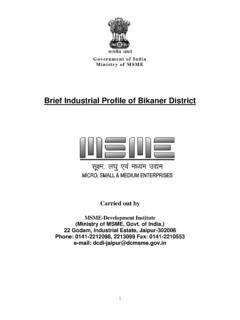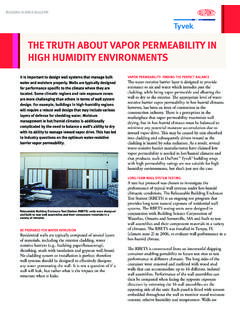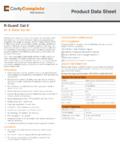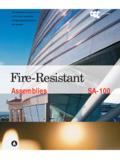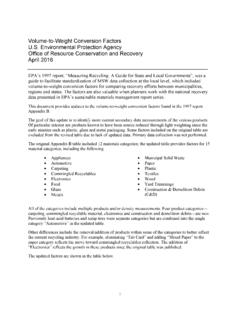Transcription of GOLD BOND brand FOIL BACK 800-NATIONAL …
1 GOLD bond brand foil BACKGYPSUM BOARDT echnical Information: 800-NATIONAL 800-628-4662 DescriptionGold bond brand foil back gypsum board consists of a fire-resistant gypsum core with a heavy, natural finish and 100-percent recycled paper on the face and a strong liner paper on the back side. A Type III aluminum foil vapor retarder, laminated to the back surface, is designed to prevent condensation from occurring within the wall it on the interior face of exterior walls and ceilings in new construction and remodeling with furred masonry, wood or steel framing. It is effective for single-layer applications and as a base layer in double-layer applications that require a vapor retarder of 1 perm or speed of installation, GridMarX guide marks are printed on the paper UsesAPPLICATIONS Use 1/2 in. ( mm) foil back gypsum board for the interior face of exterior walls and ceilings where a vapor retarder is required.
2 Also use it in non-fire-rated construction where framing members are spaced up to 24 in. (610 mm) Use 5/8 in. ( mm) foil back gypsum board where enhanced fire safety and sound transmission performance are Optimal vapor retarder that prevents condensation from occurring in the wall cavity. In accordance with ASTM E96. All-in-one board reduces installation steps and offers labor savings. Versatile product that is appropriate for use on virtually all exterior wall and ceiling construction: wood frame, steel frame and furred masonry. Excellent working properties, including score and snap, reduced dust and improved strength-to-weight ratio. Features the GridMarX preprinted fastening guide on the board to allow for faster and more accurate RecommendationsGENERAL Install gypsum board in accordance with methods described in ASTM C840 and GA-216.
3 Examine and inspect framing materials to which gypsum board is to be applied. Remedy all defects prior to installation of the gypsum board . GridMarX provides quick identification and uniform nail/screw patterns. Use GridMarX to make accurate cuts without drawing lines. GridMarX guide marks run the length of the board at five points in 4 in. (102 mm) increments. Marks run along the edge in both tapers and at 16 in. (406 mm), 24 in. (610 mm) and 32 in. (813 mm) in the field of the board . The marks cover easily with no bleed-through using standard paint products. Apply gypsum board first to ceilings at right angles to framing members, then to walls. Use boards of maximum practical length so that the minimum number of end joints occur. Bring board edges into contact with each other but do not force into place.
4 Install batt or blanket ceiling insulation BEFORE the gypsum board on ceilings when installing a vapor retarder behind the gypsum board . Install the insulation IMMEDIATELY after the gypsum board when using loose fill insulation. Avoid installation practices that might allow condensation to form behind boards. Cut gypsum board to allow for a minimum 1/4 in. ( mm) gap between gypsum board and floor to prevent potential wicking. Locate gypsum board joints at openings so that no joint will occur within 12 in. (305 mm) of the edges of the opening unless installing control joints at these locations. Stagger vertical end joints. Joints on opposite sides of a partition should not occur on the same stud. Hold gypsum board in firm contact with the framing member while driving fasteners. Fastening should proceed from center portion of the board toward the edges and ends.
5 Set fasteners with heads slightly below the surface of the board . Take 09 29 00/NGC Job Name: Contractor: Date:Submittal Approvals: (Stamps or Signatures)1(Continued on page 3)TECHNICAL DATAPHYSICAL PROPERTIES1/2" foil back gypsum Board5/8" foil back gypsum BoardThickness1, Nominal1/2" ( mm)5/8" ( mm)Width1, Nominal4' (1,219 mm)4' (1,219 mm), 54" (1,372 mm)Length1,4, Standard8' 16' (2,438 4,877 mm)8' 16' (2,438 4,877 mm)Weight, ft. ( k/m2) ft. ( k/m2)Edges1 Tapered or SquareTapered or SquareFlexural Strength1, Perpendicular 107 lbf. (476 N) 147 lbf. (654 N)Flexural Strength1, Parallel 36 lbf. (160 N) 46 lbf. (205 N)Humidified Deflection1 10/8" ( mm) 5/8" ( mm)Nail Pull Resistance1 77 lbf. (343 N) 87 lbf. (387 N)Hardness1 Core, Edges and Ends 11 lbf. (49 N) 11 lbf.
6 (49 N)Thermal Resistance5R = .45R = .56 Permeance6< perms< permsProduct Standard ComplianceASTM C 1396 ASTM C 1396 Fire-Resistance CharacteristicsCore TypeRegularType XUL Type DesignationN/AFSWC ombustibility2 Non-combustible CoreNon-combustible CoreSurface Burning Characteristics3 Class AClass AFlame Spread31515 Smoke Development300 Applicable Standards and ReferencesASTM C473 Standard Test Methods for Physical Testing of gypsum Panel ProductsASTM C518 Standard Test Method for Steady-State Thermal Transmission Properties by Means of the Heat Flow Meter ApparatusASTM C840 Standard Specification for Application and Finishing of gypsum BoardASTM C1396 Standard Specification for gypsum BoardASTM E84 Standard Test Method for Surface Burning Characteristics of Building MaterialsASTM E96 Standard Test Methods for Water Vapor Transmission of
7 MaterialsASTM E136 Standard Test Method for Behavior of Materials in a Vertical Tube Furnace at 750 CGypsum Association, GA-214, Recommended Levels of Finish for gypsum board , Glass Mat and Fiber-Reinforced gypsum PanelsGypsum Association, GA-216, Application and Finishing of gypsum Panel ProductsGypsum Association, GA-238, Guidelines for Prevention of Mold Growth on gypsum BoardNational gypsum Company, NGC Construction Guide1. Specified values per ASTM C1396, tested in accordance with ASTM Tested in accordance with ASTM Tested in accordance with ASTM Please consult your local sales representative for all non-standard lengths and widths. Minimum order requirements may Tested in accordance with ASTM Tested in accordance with ASTM E962care to avoid breaking the face paper of the gypsum board . Remove improperly driven nails or screws.
8 Provide minimum 1/4 in. ( mm) clearance between boards and adjacent concrete or masonry to minimize wicking of moisture. Maintain a room temperature of not less than 40 F (4 C) during application of gypsum board . Maintain a room temperature of not less than 50 F (10 C) when using adhesive to attach the gypsum board and during joint treatment, texturing and decoration, beginning 48 hours prior to application and continuously thereafter until completely dry. Maintain adequate ventilation in the working area during installation and curing back gypsum board INSTALLATION To maintain the performance of foil back gypsum board , repair damaged foil area using foil tape prior to installing gypsum board . To minimize airflow, seal penetrations, such as outlets and switches, using pads or to GA-214, Recommended Levels of Finish for gypsum board , Glass Mat and Fiber-Reinforced gypsum Panels, to determine the level of finishing needed to assure a surface properly prepared to accept the desired gypsum board surfaces, including finished joints, are clean, dust-free and gloss-free to achieve best painting results.
9 Apply a coat of a quality drywall primer to equalize the porosities between surface paper and joint compound, improving fastener and joint of a paint to provide desired finish characteristics is the responsibility of the architect or LIGHTING AREASWall and ceiling areas abutting window mullions or skylights, long hallways, and atriums with large surface areas washed with artificial or natural lighting are a few examples of critical lighting areas. Strong side lighting from windows or surface-mounted light fixtures may reveal even minor surface imperfections. Light striking the surface obliquely, at a slight angle, exaggerates surface irregularities. If you cannot avoid critical lighting, minimize the effects by skim coating the gypsum board surfaces, by decorating the surface with medium to heavy textures, or by the use of draperies and blinds, which soften shadows.
10 In general, paints with sheen levels other than flat, enamel paints and dark-toned paint finishes highlight surface defects; consider the use of textures to hide these minor visual Do not use over kraft-faced insulation or other vapor retarders. Do not use as a base for adhesively applied vinyl or other highly water-vapor resistant wall coverings. Do not use as a base for ceramic or other tile or as a base layer for prefinished vinyl wall panels in double-layer assemblies. Do not use foil back gypsum board in hot, humid climates, such as the southern Atlantic and Gulf Coast areas. Do not laminate the foil surface of foil back to any surface. Avoid exposure to excessive or continuous moisture and extreme temperatures. Do not expose gypsum board to temperatures exceeding 125 F (52 C) for extended periods of time.


